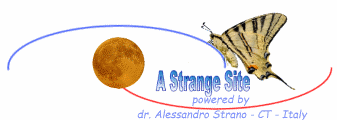Akris - Attelabos - Asirakos (1) (3) [in English]
Aristotele nella "Storia degli Animali" (libro V, 28-29) fornisce alcune informazioni su due categorie di Ortotteri che chiama rispettivamente "akris" e "attelabos". In particolare con riguardo alla prima categoria afferma che le femmine partoriscono conficcando nel terreno il "gambo" (kaulis) che hanno nella "coda" (kerkos) e che i maschi mancano del "gambo". Se non ci si è ingannati la frase è da riferire in linea di massima alle specie degli Ensiferi in cui le femmine hanno un lungo e ben visibile ovopositore all'estremità dell'addome. Pertanto Aristotele, quando puntualizza che i maschi ne sono privi, intende non solo tracciare un elemento di distinzione tra i due sessi degli esemplari degli "akris", ma definisce anche il criterio di separazione tra le due categorie di ortotteri: cioè la presenza o l'assenza nelle femmine di un ovopositore ben visibile. Pertanto con "attelabos" devono intendersi le specie dei Celiferi.
Dioscoride nella "De Materia Medica" (libro II, 57) scrive invece di un "akris" senza ali chiamato "asirakos" o "onos" (=asino). Se si ammette che "akris" abbia lo stesso significato che ha nei passi di Aristotele ecco che allora l' "asirakos" va collocato tra gli Ensiferi ed in particolare tra le ninfe e o le specie attere/brachittere e con "corpo tozzo" ["megalokolos" è stato qui così inteso e non come "grosse gambe"], come ve ne sono ad esempio nei generi Ephippiger e Barbitistes, e che nel confronto con le specie dall'aspetto più slanciato, e pertanto paragonabili a "cavalli" (2), ben possono meritare l'appellativo di "asini".
Alessandro Strano
Akris - Attelabos - Asirakos (1) (3) [in Italiano]
Aristotle in the "Historia Hanimalium" (book V, 28-29) writes about two kinds of Orthoptera called "akris" and "attelabos". Regarding "akris" he says that females lay eggs in the ground inserting the "stem" (kaulis) of their "tail" (kerkos) and that males have not a "stem". If I'm not wrong, Aristotle was speaking about Ensifera where females have indeed a long, well visible ovipositor at their abdomen apex. If so, when Aristotle say that males have not a "stem", he wants point out not only the difference between females and males of "akris" but also the difference between the two kinds of orthoptera: that is the presence or the absence of a well visible ovipositor in females. Therefore the term "attelabos" refers to Caelifera.
Dioscorides in the "De Materia Medica" (book II, 57) writes instead about a wingless kind of "akris" called "asirakos" or "onos" (=ass). If we assume that the term "akris" has the same meaning of the Aristotle's "akris" then the "asirakos" is to be placed in the order Ensifera and particularly among nymphs and or wingless/short-winged species with a "squat body" ["megalokolos" was here translated with this meaning and not as "big legs"], such as there are some in the genera Ephippiger and Barbitistes, which if compared with the slimmer species, therefore looking like "horses" (2), can be easily called "asses".
Alessandro Strano
(1) Queste riflessioni originano dallo spunto dato da / this remark was originated by the cue of Elio Corti, Elio Corti ha altresì curato la traduzione dei passi originali in greco/ he also cured the translation of the original Greek passages
Per maggiori dettagli / For more details see Dr. Elio Corti's page at http://www.summagallicana.it/lessico/a/attelebus.htm
(2) Gli ortotteri vengono talvolta paragonati ai cavalli; in italiano, ad esempio, il termine "cavalletta" è diminutivo di "cavallo".
Orthoptera are sometimes compared with horses; in Italian, for example, the word "cavalletta" (=grasshopper) is diminutive of "cavallo" (=horse).
(3) E' opinione comune che Aristotele non indichi il criterio di distinzione tra "akris" e "attelabos" (4), sebbene si assuma che con quest'ultimo termine intenda riferirsi agli Ortotteri in grado di sciamare.
It is commonly assumed that Aristotle does not show the distinguishing criteria between "akris" and "attelabos" (4) though it is assumed that with the latter he is speaking about species of Orthoptera with the ability to swarm.
(4) Plinio il Vecchio, nella "Storia Naturale" (libro XXIX, 92), usa il termine "attelebos" a proposito dei più piccoli Ortotteri senza ali.
Pliny the Older, in the "Natural History" (book XXIX, 92), uses the term "attelebos" speaking about the smallest Orthoptera without wings.
